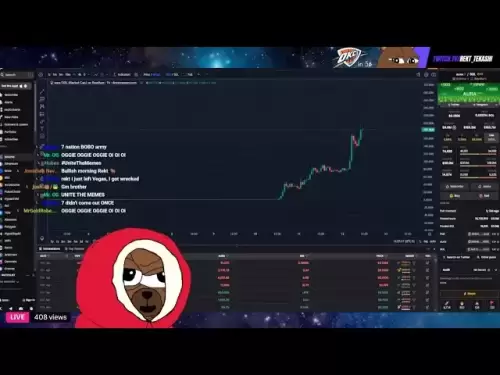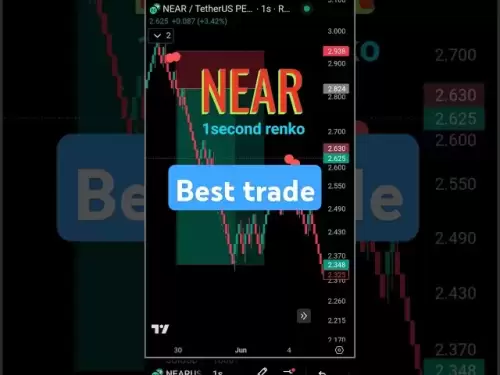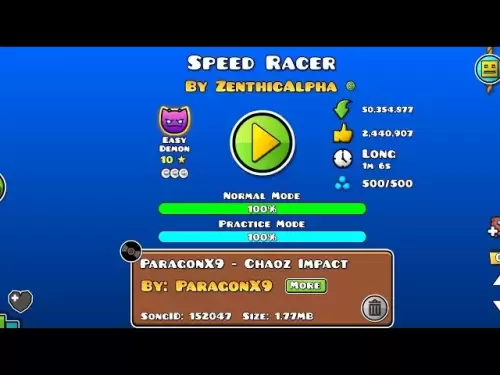-
 Bitcoin
Bitcoin $104,522.6322
-3.13% -
 Ethereum
Ethereum $2,523.2617
-8.98% -
 Tether USDt
Tether USDt $1.0004
0.05% -
 XRP
XRP $2.1152
-5.86% -
 BNB
BNB $652.2893
-2.33% -
 Solana
Solana $144.6351
-9.37% -
 USDC
USDC $0.9995
-0.03% -
 Dogecoin
Dogecoin $0.1735
-9.24% -
 TRON
TRON $0.2736
-0.43% -
 Cardano
Cardano $0.6326
-8.58% -
 Hyperliquid
Hyperliquid $38.5159
-8.14% -
 Sui
Sui $2.9977
-10.56% -
 Chainlink
Chainlink $13.2026
-9.28% -
 UNUS SED LEO
UNUS SED LEO $8.9820
1.39% -
 Bitcoin Cash
Bitcoin Cash $416.2011
-3.39% -
 Stellar
Stellar $0.2574
-7.06% -
 Avalanche
Avalanche $19.0069
-10.26% -
 Toncoin
Toncoin $2.9777
-7.56% -
 Shiba Inu
Shiba Inu $0.0...01168
-9.04% -
 Hedera
Hedera $0.1545
-9.05% -
 Litecoin
Litecoin $83.5565
-7.17% -
 Polkadot
Polkadot $3.8099
-7.40% -
 Ethena USDe
Ethena USDe $1.0004
-0.02% -
 Monero
Monero $313.0679
-4.12% -
 Dai
Dai $0.9998
0.00% -
 Bitget Token
Bitget Token $4.5157
-4.11% -
 Uniswap
Uniswap $7.3677
-9.10% -
 Pepe
Pepe $0.0...01065
-15.22% -
 Aave
Aave $279.7196
-6.75% -
 Pi
Pi $0.5464
-13.61%
How to read the K-line cross star and volume changes?
The K-line cross star, a candlestick pattern with a small body and long shadows, signals potential trend reversals or continuations when analyzed with volume changes.
Jun 12, 2025 at 11:14 am
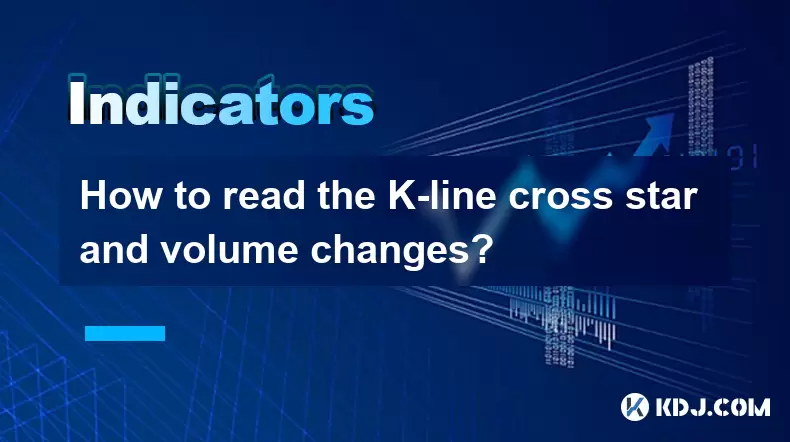
The K-line chart is a fundamental tool used by traders in the cryptocurrency market to analyze price movements and make informed trading decisions. Among the various patterns that traders look for, the cross star is particularly significant due to its potential to signal a reversal or continuation of a trend. In this article, we will delve into how to read the K-line cross star and understand the accompanying volume changes, which can provide deeper insights into market sentiment.
Understanding the K-Line Cross Star
The K-line cross star is a candlestick pattern that appears on a chart when the opening and closing prices of a cryptocurrency are very close to each other, resulting in a small body with long upper and lower shadows. This pattern can be either bullish or bearish, depending on the context in which it appears.
- Bullish Cross Star: A bullish cross star occurs when the small body is located near the lower end of the trading range, suggesting that buyers are starting to gain control after a period of selling pressure.
- Bearish Cross Star: Conversely, a bearish cross star appears when the small body is located near the upper end of the trading range, indicating that sellers are beginning to dominate after a period of buying pressure.
Identifying a Cross Star on the Chart
To identify a cross star on a K-line chart, follow these steps:
- Examine the Candlestick: Look for a candlestick with a small body and long upper and lower shadows. The body should be significantly smaller compared to the shadows.
- Check the Position: Determine whether the small body is near the top or bottom of the trading range to classify it as bearish or bullish.
- Confirm the Pattern: Ensure that the previous candlesticks show a clear trend that the cross star might be reversing or continuing.
Analyzing Volume Changes with the Cross Star
Volume is a critical indicator that can enhance the reliability of the cross star pattern. When interpreting volume changes alongside a cross star, consider the following:
- High Volume: If the cross star appears with high trading volume, it suggests strong market participation and increases the likelihood of the pattern's predictive power. High volume accompanying a bullish cross star can indicate strong buying interest, while high volume with a bearish cross star may signal significant selling pressure.
- Low Volume: Conversely, if the cross star occurs on low volume, it might indicate a lack of conviction in the market movement, reducing the reliability of the pattern.
Combining Cross Star and Volume for Trading Decisions
When using the cross star and volume changes to make trading decisions, it's essential to consider the broader market context. Here's how you can integrate these elements into your trading strategy:
- Trend Confirmation: Use the cross star to confirm trends. A bullish cross star on high volume in an uptrend can reinforce a buy signal, while a bearish cross star on high volume in a downtrend can validate a sell signal.
- Reversal Signals: Look for cross stars that appear after a prolonged trend. A bullish cross star on high volume at the end of a downtrend could signal a potential reversal, whereas a bearish cross star on high volume at the end of an uptrend might indicate an impending downturn.
- Risk Management: Always consider the risk associated with any trading decision. Even with a clear cross star and volume indication, use stop-loss orders to manage potential losses.
Practical Example of Reading a Cross Star and Volume
Let's consider a practical example to illustrate how to read a cross star and its accompanying volume changes:
- Scenario: You are monitoring the price of Bitcoin (BTC) and notice a bearish cross star forming after a prolonged uptrend.
- Volume Analysis: The bearish cross star appears on a day with significantly higher trading volume than the previous days.
- Interpretation: The high volume accompanying the bearish cross star suggests strong selling pressure, indicating that the uptrend might be losing steam. This could be a signal to consider taking profits or initiating a short position.
- Action: You decide to sell a portion of your BTC holdings and set a stop-loss order above the recent high to manage risk.
Using Additional Indicators with the Cross Star
While the cross star and volume changes provide valuable insights, combining them with other technical indicators can enhance your analysis:
- Moving Averages: Use moving averages to confirm the trend direction. A bullish cross star above a rising moving average can reinforce a bullish signal, while a bearish cross star below a falling moving average can strengthen a bearish signal.
- Relative Strength Index (RSI): The RSI can help identify overbought or oversold conditions. A bullish cross star in an oversold condition may suggest a potential reversal, whereas a bearish cross star in an overbought condition could indicate an impending downturn.
- MACD: The Moving Average Convergence Divergence (MACD) can provide additional confirmation of trend changes. A bullish cross star accompanied by a bullish MACD crossover can increase the confidence in a bullish signal, while a bearish cross star with a bearish MACD crossover can enhance a bearish signal.
Practical Tips for Reading Cross Stars and Volume
To effectively read cross stars and volume changes, keep the following tips in mind:
- Context is Key: Always consider the broader market context and the trend leading up to the cross star.
- Volume Confirmation: High volume can significantly enhance the reliability of the cross star pattern.
- Multiple Timeframes: Analyze the cross star and volume changes across multiple timeframes to get a comprehensive view of market sentiment.
- Patience and Discipline: Avoid jumping to conclusions based on a single cross star. Look for confirmation from subsequent candlesticks and additional indicators.
Frequently Asked Questions
Q1: Can a cross star be a continuation pattern as well as a reversal pattern?
Yes, a cross star can serve as both a continuation and a reversal pattern. Its interpretation depends on the preceding trend and the accompanying volume. If a cross star appears during a strong trend and is followed by a continuation of that trend, it can be considered a continuation pattern. However, if it appears at the end of a trend and is followed by a reversal, it acts as a reversal pattern.
Q2: How reliable is the cross star pattern in predicting market movements?
The reliability of the cross star pattern can vary depending on several factors, including the volume, the broader market context, and the time frame of the chart. Generally, a cross star accompanied by high volume and confirmed by other technical indicators is considered more reliable. However, no single pattern guarantees market movements, and traders should always use additional analysis and risk management strategies.
Q3: What other candlestick patterns should I look for alongside the cross star?
In addition to the cross star, traders often look for other significant candlestick patterns such as the doji, hammer, and shooting star. The doji, like the cross star, indicates indecision in the market and can signal potential reversals. The hammer and shooting star patterns, on the other hand, are strong reversal indicators that can complement the cross star's signals.
Q4: How can I practice reading cross stars and volume changes without risking real money?
You can practice reading cross stars and volume changes using a demo trading account offered by many cryptocurrency exchanges and trading platforms. These accounts allow you to trade with virtual money, enabling you to gain experience without financial risk. Additionally, analyzing historical charts and participating in trading simulations can help you hone your skills.
Disclaimer:info@kdj.com
The information provided is not trading advice. kdj.com does not assume any responsibility for any investments made based on the information provided in this article. Cryptocurrencies are highly volatile and it is highly recommended that you invest with caution after thorough research!
If you believe that the content used on this website infringes your copyright, please contact us immediately (info@kdj.com) and we will delete it promptly.
- Neo Pepe Coin (NEOP) Leads the Pack as Crypto Enthusiasts Await New Meme Coin Revolutions
- 2025-06-13 16:10:12
- Mutuum Finance (MUTM) Could Surge Past $3 by 2025, Outperforming Cardano (ADA)
- 2025-06-13 16:10:12
- OPTO Miner Launches Global Mobile Mining App Targeting Cryptocurrency Novices
- 2025-06-13 16:05:12
- ASTR Becomes the World's First Token to Integrate with Chainlink's CCIP
- 2025-06-13 16:05:12
- Bitcoin and Ethereum Struggle to Maintain Stability as the Cryptocurrency Market Experiences a Turbulent Day
- 2025-06-13 16:00:31
- LuckHunter (LHUNT) Dominates the Presale Hype, Exploring Other Top Picks
- 2025-06-13 16:00:31
Related knowledge
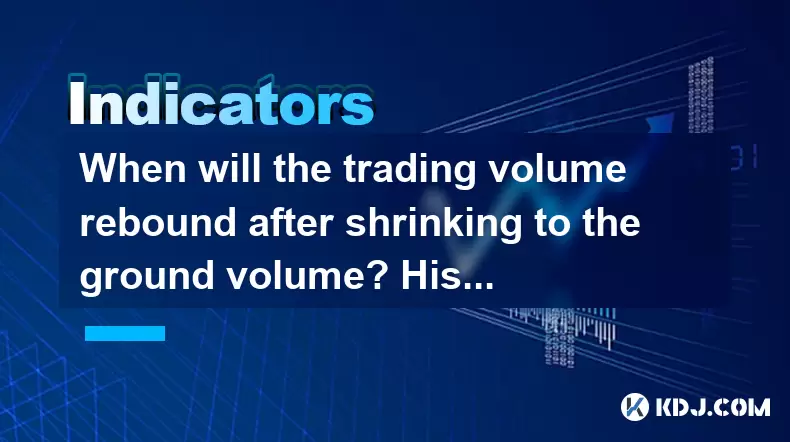
When will the trading volume rebound after shrinking to the ground volume? Historical percentile comparison method
Jun 13,2025 at 03:36pm
Understanding the Ground Volume Concept in Cryptocurrency MarketsIn cryptocurrency trading, 'ground volume' refers to a period when the trading volume of a particular asset or market drops significantly, often reaching multi-month or even multi-year lows. This phenomenon typically signals a lack of interest from traders and investors, suggesting that th...

How to read the CR indicator's four lines that diverge and then converge? Key pressure point identification skills
Jun 13,2025 at 12:21pm
Understanding the CR Indicator in Cryptocurrency TradingThe CR indicator, also known as the Chikin Ratio or Chaikin Oscillator, is a technical analysis tool widely used in cryptocurrency trading to gauge momentum and potential price reversals. It combines volume and price data to provide traders with insights into market strength and weakness. The indic...

What should I do if the ASI vibration rise and fall indicator is not synchronized with the price? When should I believe in the indicator?
Jun 13,2025 at 12:29pm
Understanding the ASI Vibration Rise and Fall IndicatorThe Accumulation Swing Index (ASI) is a technical indicator developed by Welles Wilder to help traders identify potential reversals and confirm trends in price movements. The vibration rise and fall aspect of the ASI refers to how the line oscillates above and below its zero line, indicating shifts ...
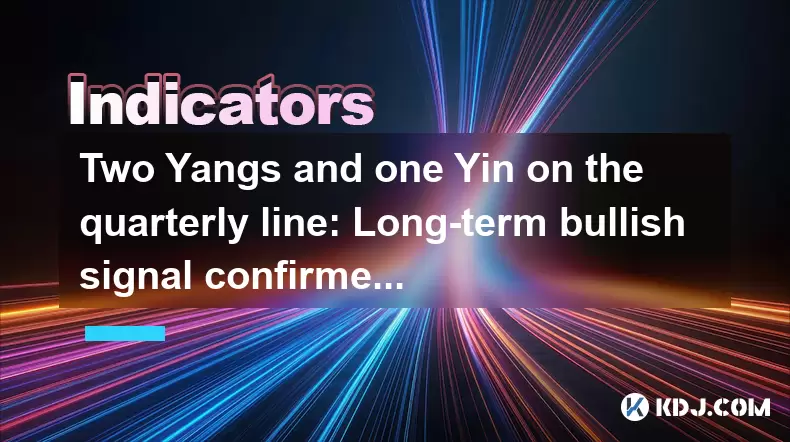
Two Yangs and one Yin on the quarterly line: Long-term bullish signal confirmed?
Jun 12,2025 at 07:00am
Understanding the 'Two Yangs and One Yin' Candlestick PatternIn technical analysis, candlestick patterns play a pivotal role in identifying potential market reversals or continuations. The 'Two Yangs and One Yin' pattern is one such formation that traders often observe on longer timeframes like the quarterly chart. This pattern consists of two bullish (...
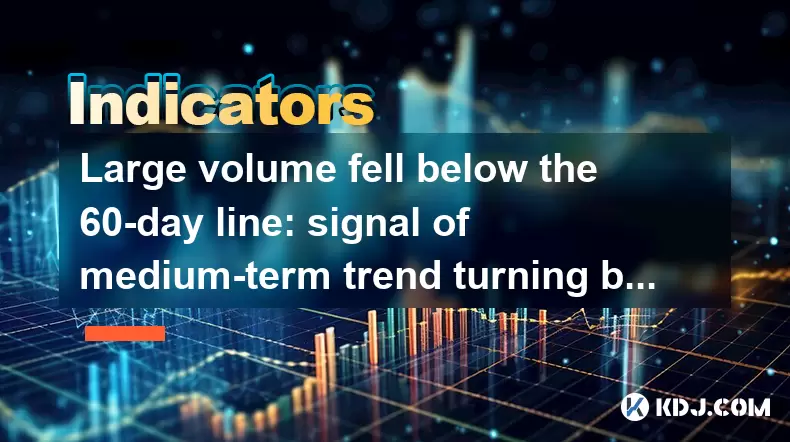
Large volume fell below the 60-day line: signal of medium-term trend turning bearish?
Jun 13,2025 at 03:42am
Understanding the 60-Day Moving Average in CryptocurrencyIn cryptocurrency trading, technical analysis plays a crucial role in predicting price movements. One of the most commonly used indicators is the 60-day moving average (MA), which smooths out price data over the last 60 days to provide traders with insights into the medium-term trend. When large v...
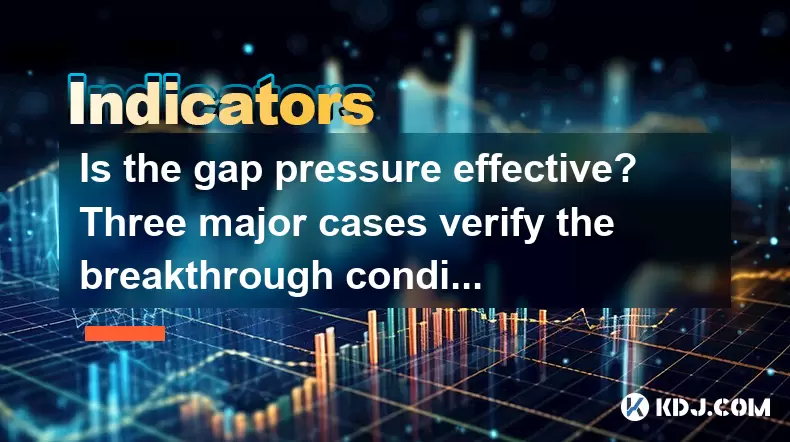
Is the gap pressure effective? Three major cases verify the breakthrough conditions
Jun 13,2025 at 04:35am
Understanding the Gap Pressure in Cryptocurrency TradingIn cryptocurrency trading, gap pressure refers to a technical analysis concept where price gaps form due to sudden market movements. These gaps often occur between the closing price of one trading session and the opening price of the next. Traders pay close attention to these gaps because they can ...

When will the trading volume rebound after shrinking to the ground volume? Historical percentile comparison method
Jun 13,2025 at 03:36pm
Understanding the Ground Volume Concept in Cryptocurrency MarketsIn cryptocurrency trading, 'ground volume' refers to a period when the trading volume of a particular asset or market drops significantly, often reaching multi-month or even multi-year lows. This phenomenon typically signals a lack of interest from traders and investors, suggesting that th...

How to read the CR indicator's four lines that diverge and then converge? Key pressure point identification skills
Jun 13,2025 at 12:21pm
Understanding the CR Indicator in Cryptocurrency TradingThe CR indicator, also known as the Chikin Ratio or Chaikin Oscillator, is a technical analysis tool widely used in cryptocurrency trading to gauge momentum and potential price reversals. It combines volume and price data to provide traders with insights into market strength and weakness. The indic...

What should I do if the ASI vibration rise and fall indicator is not synchronized with the price? When should I believe in the indicator?
Jun 13,2025 at 12:29pm
Understanding the ASI Vibration Rise and Fall IndicatorThe Accumulation Swing Index (ASI) is a technical indicator developed by Welles Wilder to help traders identify potential reversals and confirm trends in price movements. The vibration rise and fall aspect of the ASI refers to how the line oscillates above and below its zero line, indicating shifts ...

Two Yangs and one Yin on the quarterly line: Long-term bullish signal confirmed?
Jun 12,2025 at 07:00am
Understanding the 'Two Yangs and One Yin' Candlestick PatternIn technical analysis, candlestick patterns play a pivotal role in identifying potential market reversals or continuations. The 'Two Yangs and One Yin' pattern is one such formation that traders often observe on longer timeframes like the quarterly chart. This pattern consists of two bullish (...

Large volume fell below the 60-day line: signal of medium-term trend turning bearish?
Jun 13,2025 at 03:42am
Understanding the 60-Day Moving Average in CryptocurrencyIn cryptocurrency trading, technical analysis plays a crucial role in predicting price movements. One of the most commonly used indicators is the 60-day moving average (MA), which smooths out price data over the last 60 days to provide traders with insights into the medium-term trend. When large v...

Is the gap pressure effective? Three major cases verify the breakthrough conditions
Jun 13,2025 at 04:35am
Understanding the Gap Pressure in Cryptocurrency TradingIn cryptocurrency trading, gap pressure refers to a technical analysis concept where price gaps form due to sudden market movements. These gaps often occur between the closing price of one trading session and the opening price of the next. Traders pay close attention to these gaps because they can ...
See all articles





















